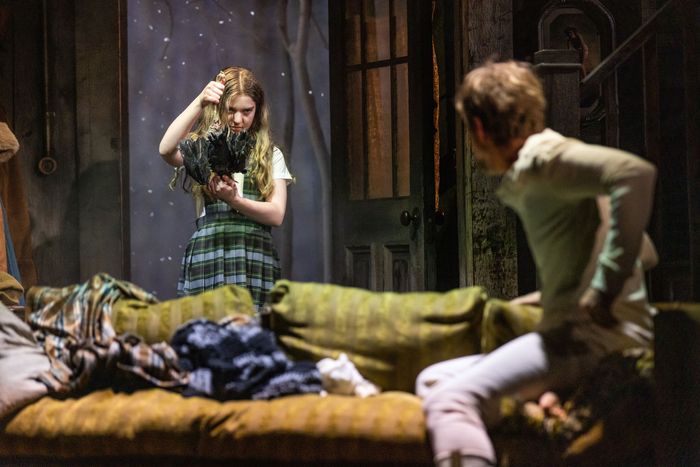
“I’ve seen this movie,” Paul Sparks says as he’s being dragged, his leg broken, into a ominous house in the woods during a snowstorm. Watching Grey House, you’ll probably be inclined to agree, though that’s not necessarily a bad thing. Levi Holloway’s play is self-consciously sipping from a cauldron of familiar horror tropes, from classics like Misery (both that the broken leg and presence of Laurie Metcalf) to more recent “elevated” indie genre films—and like a lot of those movies, it soon becomes too proud of its own metaphors. But if you’ve seen a lot of this onscreen, capital-H horror of this kind is less often done on Broadway, and in that context, the scares are fresher. The production makes a good case for more full-on spookiness onstage, even if it’s a less convincing one for this play in particular.
How scary is Grey House? That probably depends on your feelings about the innate creepiness of young girls. Sparks’s Henry and his wife, Max, played by Tatiana Maslany, get into a car accident and seek refuge in that a crumbling shack, occupied by a quartet of young women (Sophia Anne Caruso, Millicent Simmons, Colby Kipnes, Alyssa Emily Marvin), their stern older minder (Metcalf), and an eerily shy boy they all care for (Eamon Patrick O’Connell). Scott Pask’s set—the play takes place in the 1970s, seemingly just for the atmosphere and lack of cell phones—will start to unnerve you immediately, before you even learn that the girls have names like “Squirrel” and “A1656.” The foursome begin tending to Henry while acting more suspicious of Max, talking over one other as they enlist her in their seemingly supernatural children’s games. (You may want to shout “Don’t stand in the middle of a satanic-looking rune and agree to play ‘Show and Hell’!”) There’s only so many times kids can say things like “tell a lie and a mama die” before things turn silly, and Caruso, who is the alpha girl here, leans on an overenunciated delivery that crosses the line from foreboding into Regina George.
Between those scenes, however, Grey House does get genuinely unsettling, especially as Sparks’s Henry experiences moonshine-fueled hallucinations (or are they real?). Joe Mantello, picking up with Metcalf where that pandemic-shuttered Virginia Woolf left off, directs a few old-fashioned theater-trickery jumpscares: A figure suddenly appears above a fridge at the back of the set, we are treated to a handful of sudden blackouts, and the contents of that fridge change nearly every time a character opens it. While the girls tend toward artifice, Mantello gets good naturalistic performances from the adults. Sparks, as always, descends into madness well, and Maslany finds a brittleness that aligns with her character’s recent loss of a sister. Though Metcalf’s den mother is really more of a secondary character, she is always a delight to watch onstage. She can set even a dud of a line spinning by delivering it with the right lumbering resentment. Her protectiveness of and frustration with her charges in this weird mountain house gives the situation a baseline emotional reality, even as the play’s mythology starts to strain.
I won’t try to explain what exactly is going on in the Grey House, both in order to avoid spoiling the plot and because I’m not entirely sure myself. (The production sent over a PDF explaining the lore to critics after they attended, which may be a sign that things aren’t entirely clear in the performance.) I’ll just say that Holloway inches toward a double-underlined, not exactly groundbreaking message about how men treat women, though the more the play tried to emphasize its insights, the less I bought into them. Things are better unspoken, as in a gory set piece near the end of the play that’s accompanied by some haunting music (heed the chilling credit of “a cappella arranger” Or Matias in your program) that’s stuck with me more than any of the direct exposition.
That late sequence serves as a reminder that, whatever you might assume from the proliferation of big loud spectacle on Broadway, theater is often a perfectly natural space for scaring us. What you lose without close-ups and CGI, you gain from sitting among many people in the dark helplessly watching an unthinkable act unfold in front of you. The scariest thing I’ve seen in a theater was probably Dana H., with its overwhelming sense of dread. Same goes for This Is a Room and the more directly bloody The Thin Place or the oblique Anatomy of a Suicide (or even some elements of The Humans). None of those lean on filmic horror elements to the extent that Grey House does, and they originated in smaller spaces. Once you get to huge Broadway houses, claustrophobia is harder to maintain—it was distracting, watching Grey House, to hear parts of the audience giggle at the scares. But it was also fun to see the production swing so hard at genre tropiness. If it doesn’t fully succeed on its own terms, it’s at least a solid reminder that terror is as worthy of drama as any other kind of spectacle.
Grey House is at the Lyceum Theatre.


